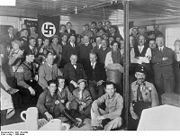
What I Saw: Reports from Berlin, 1920-1933
Encyclopedia
What I Saw: Reports from Berlin, 1920-1933 is a book of impressionistic and political writings, by the German writer Joseph Roth
. The writings, that cover the period of the Weimar Republic
, " record the violent social and political paroxysms that constantly threatened to undo the fragile democracy" of those years , - but also include more prosaic aspects of Berlin
such as the public parks and the rising entertainment industry. The English translation of this collection of pieces, by the poet Michael Hofmann
, was first published in 2003.
Born into a Jewish family in Galicia
, on the eastern edge of the Austro-Hungarian Empire, Joseph Roth arrived in Berlin, the capital of the Weimar Republic in 1920. On Hitler's assumption of power he was obliged to leave Germany. He died, in poverty, in Paris.
 "Roth, like no other German writer of his time, ventured beyond Berlin's official veneer to the heart of the city, chronicling the lives of its forgotten inhabitants - the war cripples, the Jewish immigrants, the criminals, the bathhouse denizens. Warning early on of the threat posed by the Nazis, Roth evoked a landscape of moral bankruptcy
"Roth, like no other German writer of his time, ventured beyond Berlin's official veneer to the heart of the city, chronicling the lives of its forgotten inhabitants - the war cripples, the Jewish immigrants, the criminals, the bathhouse denizens. Warning early on of the threat posed by the Nazis, Roth evoked a landscape of moral bankruptcy
and debauched beauty, a memorable portrait of a city at a critical moment in history."
The volume is divided into nine sections: What I Saw, The Jewish Quarter, Displaced Persons, Traffic, Berlin Under Construction, Bourgeoisie and Bohemians, Berlin's Pleasure Industry, An Apolitical Observer Goes to the Reichstag, and Look Back in Anger.
Joseph Roth
Joseph Roth, born Moses Joseph Roth , was an Austrian journalist and novelist, best known for his family saga Radetzky March about the decline and fall of the Austro-Hungarian Empire, and for his novel of Jewish life, Job as well as the seminal essay 'Juden auf Wanderschaft' translated in...
. The writings, that cover the period of the Weimar Republic
Weimar Republic
The Weimar Republic is the name given by historians to the parliamentary republic established in 1919 in Germany to replace the imperial form of government...
, " record the violent social and political paroxysms that constantly threatened to undo the fragile democracy" of those years , - but also include more prosaic aspects of Berlin
Berlin
Berlin is the capital city of Germany and is one of the 16 states of Germany. With a population of 3.45 million people, Berlin is Germany's largest city. It is the second most populous city proper and the seventh most populous urban area in the European Union...
such as the public parks and the rising entertainment industry. The English translation of this collection of pieces, by the poet Michael Hofmann
Michael Hofmann
Michael Hofmann is a German-born poet who writes in English and a translator of texts from German.-Biography:...
, was first published in 2003.
Born into a Jewish family in Galicia
Kingdom of Galicia and Lodomeria
The Kingdom of Galicia and Lodomeria was a crownland of the Habsburg Monarchy, the Austrian Empire, and Austria–Hungary from 1772 to 1918 .This historical region in eastern Central Europe is currently divided between Poland and Ukraine...
, on the eastern edge of the Austro-Hungarian Empire, Joseph Roth arrived in Berlin, the capital of the Weimar Republic in 1920. On Hitler's assumption of power he was obliged to leave Germany. He died, in poverty, in Paris.

Moral bankruptcy
Moral bankruptcy is a synonym for immorality that has gained popular usage in the fields of business and politics, in which it specifically implies some instance of political corruption or corporate crime...
and debauched beauty, a memorable portrait of a city at a critical moment in history."
The volume is divided into nine sections: What I Saw, The Jewish Quarter, Displaced Persons, Traffic, Berlin Under Construction, Bourgeoisie and Bohemians, Berlin's Pleasure Industry, An Apolitical Observer Goes to the Reichstag, and Look Back in Anger.

